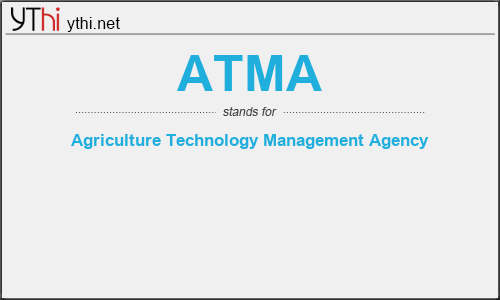What does ATMA mean? What is the full form of ATMA?
The full form of ATMA is Agriculture Technology Management Agency.
In order to address the key constraints faced by extension system in the country with respect to reducing capacity of public extension services, its lack of decentralized and demand driven focus, the Innovations in Technology Dissemination component of National Agricultural Technology Project (NATP) was implemented in seven States in the country namely, Andhra Pradesh, Bihar, Himachal Pradesh, Jharkhand, Orissa, Maharashtra and Punjab through four project districts in each State. This component aimed at pilot testing new institutional arrangements for technology dissemination at district level and below in order to move towards an integrated extension delivery. The project process involved adopting bottom up planning procedures for setting the research and extension agency in order to make the technology dissemination farmer driven and farmer accountable. The extension delivery was oriented towards group approach catering to the location specific requirement of the farmers. Gender concerns have been given adequate emphasis under the project. It functions as a registered society at District level and serves as a focal point for integrating research and extension activities and helps in decentralizing the management of agricultural technology transfer.
The purpose of NATP’s innovation in Technology Dissemination Component is to pilot test new organizational arrangements and operational procedures not merely strengthen the existing extension system. One key concept or goal is to decentralize decision-making to the district level through the creation of Agricultural Technology Management Agency (ATMA). A second goal is to increase farmer input into programme planning and resource allocation, especially at the Block level, and to increase accountability to stakeholders. A third major goal is to increase programme coordination and integration, so that the programme thrust such as farming System innovations, Farmer organization, Technology gaps and Natural Resource Management can be more effectively and efficiently implemented.
The ATMA at district level would be increasingly responsible for all the technology dissemination activities at the district level. It would have linkage with all the line departments, research organizations, non-governmental organizations and agencies associated with agricultural development in the district. Research and Extension units within the project districts such as ZRS or substations, KVKs and the key line Departments of Agriculture, Animal Husbandry, Horticulture and Fisheries etc. would become constituent members or Key stake holders of ATMA. Each Research-Extension(R-E) unit would retain its institutional identity and affiliation but programmes and procedures concerning district-wise R-E activities would be determined by ATMA Governing Board to be implemented by its Management Committee (MC).
This Scheme was approved on 29th March, 2005. The Scheme has made extension system farmer driven and farmer accountable. 237 Agricultural Technology Management Agency (ATMA) at district level have been set up to operationalise the extension reforms with active participation of farmers / farmer groups, NGOs, Krishi Vigyan Kendras, Panchayati Raj Institutions and other Stakeholder operating at district level and below. The release of funds are based on Strategic Research and Extension plan (SEWP)/ State Extension Work Plans (SEWPs) prepared by the State Governments. State level Extension Plans have been developed keeping in mind the strategic extension needs of the farmers. 252 districts across all the States/UTs in the country were covered under the scheme during the 10th Plan.
Objectives :
The objectives of ATMA are
- To strengthen research – extension – farmer linkages
- To provide an effective mechanism for co-ordination and management of activities of different agencies involved in technology adaption / validation and dissemination at the district level and below.
- To increase the quality and type of technologies being disseminated.
- To move towards shared ownership of the agricultural technology system by key shareholders.
- To develop new partnerships with the private institutions including NGOs.
Salient Features of ATMA :
- Creating Farmer Advisory Committee to improve feed back.
- Using NGOs to organize farmers.
- Encouraging private sector involvement in technology transfer.
- Validation and refining technologies through research units in the district.
- Bottom up planning procedure.
- Increased use of Information Technology (ARIS, WWW)
- In-service training to increase staff competence.
- Developing new Public-Private partnerships.
- Formation and strengthening of farmer’s interest group
ATMA
means
Agriculture Technology Management Agency![]()
Translate Agriculture Technology Management Agency to other language.


Leave a Reply
You must be logged in to post a comment.